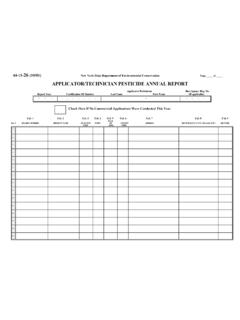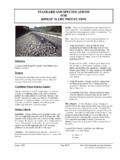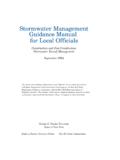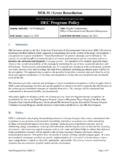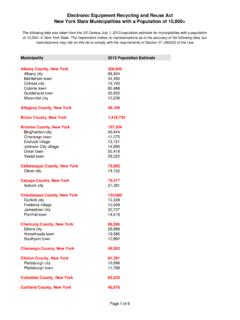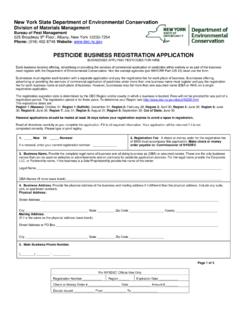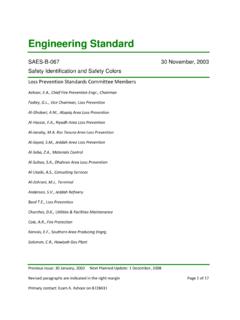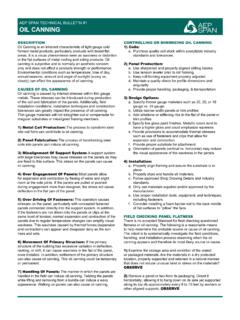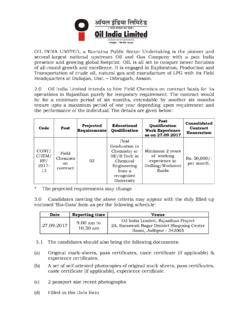Transcription of XII. OLD OIL FIELD WATERPLOOD OPERATIONS AND …
1 XII. OLD OIL FIELD WATERPLOOD OPERATIONS AND ENHANCED OIL RECOVERY POTENTIAL A. INTRODUCTION Substantial emphasis has been placed on secondary and enhanced oil recovery techniques in recent years. Research in enhanced oil recovery advanced because of higher exploration costs, increased demand for petroleum products, and decreased replacement of domestic reserves. Usually, only 5 to 30 percent of a reservoir's original-oil-in-place (OOIP) can be recovered by production. As much as 30 percent more of the OOIP may be recovered by supplementing primary energy with secondary recovery techniques. In selected reservoirs, an additional 30 percent of the OOIP may be recovered by application of tertiary or enhanced oil recovery processes. Primary production accounted for approximately 7 percent recovery of the OOIP in New York State's old oil fields.
2 Secondary recovery by waterflooding has resulted in an average recovery of an additional 14 percent of the OOIP. Waterflooding in the old oil fields has continued to the present. Twenty- eight percent of 1986 oil production in New York is attributed to this technique. During initial FIELD development, the operator strives to recover as much oil and gas as possible during the primary stage of production by efficiently utilizing the reservoir's natural energy to drive oil through the rock pores and into the producing wells. This natural energy results from: 1) the downward expansion of gas overlying the oil (gas cap drive); 2) the expansion of gas in the oil (solution gas drive); 3) water intrusion into the oil- bearing zone from an aquifer (water drive) and; 4) the force of gravity (gravity drive). In many reservoirs, all four drive mecllanisms may be present, but only one or two recovery mechanisms will dominate.
3 During the life of a reservoir, shifts in recovery mechanisms may occur. For example, a volumetric reservoir under solution gas drive may shift to a gravitational drive after the natural pressure is depleted. The purpose of this chapter is to examine the various methods of enhanced oil recovery and their impacts in New York State.. B. DEFINITIONS The literature concerning oil recovery methods employed after primary production has different definitions for secondary and tertiary recovery OPERATIONS . Some authors restrict "Enhanced Oil Recovery" to the tertiary mode while others consider it to include both secondary and tertiary recovery. Others view secondary OPERATIONS involving water or gas injection in conjunction with any additives, chemicals or other gases, as tertiary techniques. For the purpose of this text, the terms secondary and tertiary will apply to the order in which an operation is conducted rather than any actual characteristics, and the term enhanced recovery will include all recovery methods other than those dependent on a reservoir's internal energy.
4 And reservoir properties must be defined prior to discussing 2' ' enhanced recovery methods. Ideally, these properties are determined from data. gathered during the drilling and primary production phases. However, it should be noted that most oil wells in New York predate the use of sophisticated petroleum engineering data gathering and analysis techniques. During or immediately after the drilling of a well, core samples may be obtained and well logging OPERATIONS are conducted to analyze the pay zone. These initial tests provide the engineer with enough information to determine whether the well should be completed or plugged and abandoned. Specific information which is later used to evaluate the application of enhanced recovery methods is also gathered at this time. The following physical data are essential for such an evaluation: 1.
5 Permeability - is the ability of the rock to allow fluid movement through its interconnected pores. For reservoir analysis, the following terms are derived from permeability: a. effective permeability - is determined for a given fluid at a saturation less than 100 percent and is the fluid conductivity of the porous media at a given saturation where,other fluids are present. b. absolute permeability - is the permeability of a rock that transports a single fluid at 100 percent saturation. This term is most useful when determining rates of production or injection. c. relative permeability - is the ratio of the effective permeability to the absolute permeability. 2. Porosity - is that fraction of the rock volume occupied by pore space. 3. Saturation - is the percentage of pore volume occupied by a specific fluid such as gas, oil or water.
6 4. Wettability - is the tendency of one fluid to spread on or adhere to the rock surface. 5. Fluid viscosity - is the ability of a fluid to resist flow. The less viscous a fluid, the greater its mobility. (Typical viscosity of the light oil produced in New York ranges from 2 to 6 centipoise with corresponding gravities of 37" to 43" API.) 6. Original-oil-in-place - is the portion of the total pore volume occupied by oil at initial conditions and is determined volumetrically from analysis of cores and logs. 7. Recovery factor - is the percentage of original oil in place which can be recovered by the application of a specific recovery mechanism. Although other significant parameters are involved, the above information is the basic data necessary for an evaluation of the potential for enhanced recovery. During the primary production phase, other reservoir characteristics are evaluated which include the following: 1.
7 Homogeneity of reservoir - is the degree of consistency in a reservoir. The homogeneity can be approximated by analyzing well interference tests, production and pressure histories, core data and logs, and other petrographic and stratigraphic information. 2. Dip - is the average angle of inclination from horizontal of the strata in a reservoir. 3. Diffusivity - is the determination of the rate at which a fluid will readjust in response to a pressure disturbance in the reservoir. Although these factors are important, dip and diffusivity are not commonly considered in New York due to the relative maturity and horizontal nature of the State's oil reservoirs. The best method for determining the feasibility of a full scale enhanced recovery operation is the pilot project. Especially useful in undeveloped areas, a pilot project is a mini-operation designed to assess the performance of the enhanced recovery technique before large quantities of capital are committed to a full scale project.
8 The location of the wells is chosen to best represent the majority of the reservoir. The operating condition of the pilot wells must be closely monitored for an accurate evaluation of the project. The information derived from a pilot is used to better evaluate the following: 1. Incremental oil recovery 2. Optimum pattern configuration 3. Saturation distributions 4. Areal sweep efficiency - the ratio of the volume swept at any time to the total volume subject to intrusion. 5. Mobility - the ratio of the permeability to viscosity with a single fluid in reservoir. When one fluid is displaced by another, the mobility ratio is defined as mobility of the displacing fluid to that of the displaced fluid. C. WATERFLOODING 1. General When the economic limit of a FIELD under the primary stage of production is reached, a determination must be made as to the future production potential of the FIELD .
9 The application of one or more enhanced recovery techniques may be warranted based on reservoir characteristics and past production performance. Although waterflooding is the most commonly applied secondary recovery method, other enhanced recovery techniques utilizing miscible fluids, chemicals, or heat may be applied based on the characteristics of the reservoir rock and fluids. A production potential of 1,000 - 2,000 barrels per acre-foot is a generally accepted minimum yield for initiation of a waterflood. Oil price, water availability, construction costs, drilling and/or workover costs, etc., will also affect the ultimate feasibility of the project . The amount of oil displaceable by water can be determined from relative permeability data and core testing. Typical sandstones can be flooded to a residual oil saturation of 10 - 40 percent.
10 Carbonate reservoirs, which may have extremely complicated pore geometries, can have much lower displacement efficiencies. In sandstones, the residual oil saturation to waterflooding is also governed by the interfacial tension at the oillwater phase boundary. Absolute permeability and homogeneity in the pay zone and the mobility ratio of the oil and water are critical to sweep efficiency. However, injection well locations and completion methods are also important. After deciding to initiate a waterflood operation, the operator will choose a well pattern. The majority of waterflood OPERATIONS in the utilize the "five-spot" waterflood configuration. Figure indicates this and other flooding patterns. The five-spot pattern offers quick response and good sweep efficiency, and it conforms well to existing spacing patterns.



